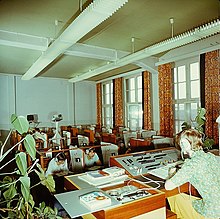language lab
A language laboratory (also called a language cabinet ) is a room specially equipped for learning languages or software that enables language laboratory functions; mobile hardware systems are also possible. Language laboratories are often found at schools or universities . It is used for active training in speaking and understanding.
description
In the beginning, the laboratory consisted of rows of individual cubicles, most of which were aligned with the front of the teacher's desk, from which the learning programs were played at the students' desks. All students had headphones with a microphone . The teacher had a control desk with the help of which they could either speak to all students via headphones and a microphone or contact and control them individually. There were language laboratories for listening only, for hearing and speaking, and for hearing, speaking and recording the student's voice. Ideally, the students are separated by partition walls in order to achieve a certain acoustic isolation, but also so that the student can act separately from other students.
history
The concept of the language laboratory goes back to the psychologist B. F. Skinner . The language laboratory spread throughout the United States since the 1950s and in the Federal Republic of Germany since the 1960s. Due to the economic and political situation, the teaching of modern foreign languages was introduced nationwide for all schools. Today the language laboratory is mostly being replaced by computer work rooms.
In the language laboratory, the so-called audiolingual method was typically used for teaching, which in terms of learning theory referred to Skinner's behavioral psychology, while language description was based on the structuralist language description according to Bloomfield . Skinner argued that language learning is learnable like behavior. Teaching is therefore based on the stimulus-response scheme , followed by positive reinforcement (reward). Learning is done through imitation, so the exercise scheme provided a stimulus, a student response, correct tape solution, and repeating the correct solution. Bloomfield introduced a descriptive view of language and therefore superseded the predominance of grammar teaching, which referred to the Latin grammatical categories. Since the 1970s and 1980s, the audio-lingual method has been replaced by the so-called communicative method, which, in addition to listening and speaking, also deals with reading and writing in the foreign language.
Modern versions
Nowadays language laboratories are at least partially equipped with software. In the language laboratory, the student PCs (fully-fledged multimedia computers with keyboard, mouse, screen and headset ) are connected to a teacher's PC and / or server via LAN. The lecturer can send video clips with sound to the students on their computers. They can then speak to it themselves (for example a market scene) and then compare what they said and what the original sound is. This is supported by an optical display of the speech modulation ( waveform analysis). The lecturer can listen to every student, speak to him, send him texts and much more. Of course, everything can also be projected.
advantages
One advantage of the language laboratory is the longer speaking and thus practice time that the student has compared to the conventional teacher-student dialogue. In normal lessons, the available time is shared among all students, which is why each student usually does not have more than 2-3 minutes for practicing with the teacher. With a language laboratory, however, it is possible that all students can practice at the same time, which is why the speaking time increases tenfold. The teacher does not lose control of the students and the students have the opportunity to ask questions to the teacher without being overheard by classmates.
criticism
Language laboratories are expensive to purchase. When language laboratories were initially “cassette-based”, the technology was maintenance-intensive and booths often couldn't be used. Another problem was that both students and teachers were often overwhelmed with the operation.
See also
swell
- Reinhold Freudenstein: Language laboratory teaching material. Technology, methodology, didactics. Kamp Verlag, Bochum 1975, ISBN 3-592-71420-1 .
- Language laboratory in Graz

